 Sitting here with my now well broken-in Mac Mini, newly running Apple’s au courant Yosemite OS, keying this post in with a Bluetooth-enabled Apple keyboard, watching my work on dual monitors, listening to some of my favorite music on a pair of UE Boom Bluetooth speakers, my cellphone of limited intelligence and its Bluetooth headset at hand, our Bengal cat Billie snoozing on the desk in front of me, I wonder what my 71st year will bring.
Sitting here with my now well broken-in Mac Mini, newly running Apple’s au courant Yosemite OS, keying this post in with a Bluetooth-enabled Apple keyboard, watching my work on dual monitors, listening to some of my favorite music on a pair of UE Boom Bluetooth speakers, my cellphone of limited intelligence and its Bluetooth headset at hand, our Bengal cat Billie snoozing on the desk in front of me, I wonder what my 71st year will bring.
Professionally speaking, this past year proved unusually uneventful, even by recent standards. Travel no longer holds much attraction for me (been there, done that), so I welcomed the chance to spend most of the year here at home, enjoying the changes of the seasons and our daily routines.
 I made only two trips out of town for professional purposes, one to Baltimore in March to accept the Insight Award at the 51st Society for Photographic Education National Conference and the other to Minneapolis in May (the latter to prepare for an upcoming Edward Curtis project). And just a few short car/bus trips, all for personal reasons — one to Bethesda, MD, for the second wedding of my younger brother Dennis, the other two to Woodstock, NY for the birthday of and, months thereafter, the third wedding of my oldest friend, Doug Sheer.
I made only two trips out of town for professional purposes, one to Baltimore in March to accept the Insight Award at the 51st Society for Photographic Education National Conference and the other to Minneapolis in May (the latter to prepare for an upcoming Edward Curtis project). And just a few short car/bus trips, all for personal reasons — one to Bethesda, MD, for the second wedding of my younger brother Dennis, the other two to Woodstock, NY for the birthday of and, months thereafter, the third wedding of my oldest friend, Doug Sheer.
The Year in Cybertravel
However, using my distance-learning skills, I made two virtual visits to classrooms. The first brought me to the Dept. of Art & Design at Adrian College and Garin Horner’s undergraduate students, to whom he’d assigned a series of writing exercises I developed in my own teaching practice. The second put me in front of Juliet Hacking’s M.A. students at Sotheby’s Institute of Art in London, for a discussion of the issues raised by the inquiry at this blog into Robert Capa’s D-Day images and their fate. (See below.)
Through a project originated by Ruth Skinner, an installation called “Reading Room: Collaborations with A. D. Coleman,” which will travel to different sites, I engaged in several online dialogues with an assortment of Canadian artists, photographers, and emerging art professionals.
Skinner is currently pursuing an MA in Art History at Western University in London, Canada (London is a city in southwestern Ontario). She had come across my writings in the course of her studies, and envisioned a comfortable physical setting for engaging with them in small-group dialogues. When she emailed to ask my permission to use my name in presenting this, we kicked it around between us, one thing led to another, and it gradually took its present shape.
The basic premise: A selection of my writings, in both physical and digital form, is made available in a space that includes a table, chairs, reading lamp, and computer. Participants read selections and, at prearranged times, join me online for a freewheeling discussion of the issues raised by those writings, via Google+ Hangouts. A video record of the conversation gets posted online at YouTube. (Click here for the videos of the sessions so far.)
We’re developing a website devoted to this concept, to be fleshed out in the coming months, and we plan more episodes of this open-ended project, starting in spring 2015. Skinner can create the installation in any space, private or public, either in person or via emailed instructions. (So far she’s used a private apartment that doubles as a gallery.) Duration of any given installation is flexible, as is the frequency of my online sessions. If interested in hosting such an event in your private or public space (which can include a space within your department or school), contact Skinner for details.
I enjoy working in these ways as a teacher, lecturer, and visiting critic / historian / curator. It spares me the wear and tear of travel, takes place at times convenient to all involved, and enables me to work with organizations and institutions that couldn’t afford the cost of hosting me in person. My fees are reasonable, and negotiable. If you’re interested, contact me here; if you know someone who might be, pass it on.
The Year in Print and Pixels
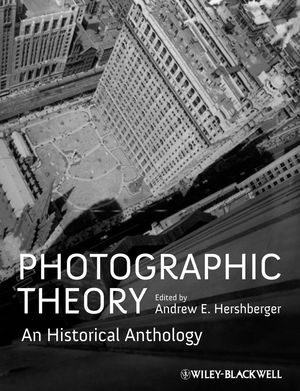 Insofar as my writing goes, over the past 12 months I saw my 1976 Artforum essay “The Directorial Mode: Notes Toward a Definition” reprinted in Photographic Theory: An Historical Anthology, edited by Andrew E. Hershberger, from Wiley-Blackwell. The Handmade Photograph, a new journal published and edited by Wendy Erickson, featured my 2009 essay, “Memory’s Mirror: The Photographs of Jerry Spagnoli,” in the Summer 2014 (#2) issue. And I continued my series of “Letter from New York” columns for the now-quarterly Hotshoe, from the U.K.
Insofar as my writing goes, over the past 12 months I saw my 1976 Artforum essay “The Directorial Mode: Notes Toward a Definition” reprinted in Photographic Theory: An Historical Anthology, edited by Andrew E. Hershberger, from Wiley-Blackwell. The Handmade Photograph, a new journal published and edited by Wendy Erickson, featured my 2009 essay, “Memory’s Mirror: The Photographs of Jerry Spagnoli,” in the Summer 2014 (#2) issue. And I continued my series of “Letter from New York” columns for the now-quarterly Hotshoe, from the U.K.
A brief new essay, “William Mortensen Reconsidered,” appeared in A Pictorial Compendium of Witchcraft: William Mortensen, 1897-1965, a substantial catalogue published by Stephen Romano. Click here for a free PDF download of the catalogue, courtesy of Romano, who has set up a website devoted to all things Mortensen. (The show on which it’s based will be on view through December 31 at Romano’s eponymous DUMBO gallery.) And click here for an online portfolio of 60 of Mortensen’s 1930s-era Hollywood portraits, from the collection of Deborah Irmas.
Inevitably, I suppose, though not exactly by plan, I’ve turned into the godfather (perhaps also the Godfather) of the Mortensen revival that’s now in full swing. This traces back to a footnote in that 1976 essay on the directorial mode, in which I took historian and curator Beaumont Newhall to task for purging Mortensen from the medium’s history. That sparked the interest of others, who began rethinking Mortensen’s work, his methods, and his approach to the medium.
Nowadays, consequently, I get credited with returning him to the discourse, as you’ll see in Elizabeth Hand’s November 28 review for the Los Angeles Times of the new monograph American Grotesque: The Life and Art of William Mortensen, edited by Larry Lytle and Michael Moynihan, recently published by Feral House. (The same publisher has issued a facsimile reprint of one of the two major monographs Mortensen published during his lifetime, The Command to Look: A Master Photographer’s Method for Controlling the Human Gaze.)
American Grotesque includes my 1982 essay “Conspicuous by His Absence: Concerning the Mysterious Disappearance of William Mortensen,” the first major critical reassessment of his contributions to the medium. You can download a free PDF of American Grotesque at the publisher’s website, and view a short video about him there as well.
I contributed an introduction, “Rochester, New York: After the Kodak Century,” to the monograph Kodak City, by Catherine Leutenegger (Kehrer Verlag), which I’ve posted here at the blog. I also collaborated with Gregory Eddi Jones on “In Dialogue with A. D. Coleman,” an exchange on matters digital (including digital self-publishing), published at his blog In the In-Between. And, just a bit off-topic, I contributed some reviews of new digital technology to Mac Edition Radio.
That’s in addition to the roughly 60 essays posted here at Photocritic International over this same stretch. Those included what evolved into a book-length inquiry into and dismantling of the myth of Robert Capa’s actions on Omaha Beach on D-Day, June 6, 1944, and the subsequent fate of his images. This resulted in Time, Inc. correcting a deceptive video it had commissioned from Magnum Photos, and forced former LIFE magazine picture editor John Morris to recant much of his previous account of that episode on Christiane Amanpour’s CNN show in November.
That constitutes a significant revision of a legendary episode in the histories of photography and photojournalism. And, given how far this fiction spread during the 70 years during which Morris and others (including, briefly, Capa himself) promulgated it, that represents a notable revision of cultural history as well. I plan to pull the fruits of this investigation together into one or more feature articles for periodicals, and a book as well.
Technology Matters
I continue to work primarily on my Mac Mini, a desktop model. Both it and my portable MacBook Pro failed almost simultaneously in early November, leaving me scrambling for ten days. To my surprise and relief, an upgrade of their OS to Apple’s current iteration, Yosemite, appears to have solved the problems of both machines. (I’d been running Mountain Lion up till then.) For some time now I’ve made it a habit to back everything up hourly, so I spared myself any anxiety over lost data — a policy I recommend to all of you. Add it to your New Year’s resolutions.
During the downtime of those two instruments I turned to a 2005 eMac that I’d stored in a guest room. Slow and clunky by comparison, running a severely outdated Apple OS (Tiger), it nonetheless enabled me to write, check email, and otherwise keep things going while sorting out the problems with the newer computers. Now it sits in a corner of my workspace, where I boot it up every week or so to make sure it runs and let it know I care.
I’ve added a few peripherals to my main system: a Logitech webcam and headset for videoconferencing and distance-learning engagements, a USB 3.0 hub. But, with Murphy’s Law in mind, I try to keep new hardware to a minimum. For example, the Kobo tablet I started to use a year ago failed, and got sent back to the company. They’d sent it as a review unit, and never shipped a replacement.
I’m still using the same basic apps: Word, Excel, Filemaker Pro, Keynote, Photoshop, Dreamweaver, and now InDesign. I added that last to my toolkit this year for several series of books I planned to start self-publishing in 2014. Those didn’t progress as quickly as I’d hoped, so they’re still in production, but I hope to get the first ones out in early 2015.
This year my wife Anna went cross-platform, with a brand-new MacBook Pro of her own, plus an iPhone and an iPad Mini. So I can use her iPad to test my ebooks, once I get them ready for previewing. And, should I find myself in a real computer crisis, until it gets resolved I can share her MacBook Pro.
Meanwhile, as noted above, our Bengal cat Billie now spends a lot of her time napping on my desk in a spot she’s claimed as her own: right in front of the monitors, tucked against my Apple Airport Extreme. She’s there as I write this. I don’t know whether to classify her as a peripheral, an app, or an extension of my own wetware, but she makes a welcome addition to my toolkit.
Happy Birthday to Me
My thanks to those readers who’ve emailed or called or posted on my Facebook timeline to offer birthday salutations. Because my birthday and Xmas and Hannukah come so close together, I became accustomed long ago to getting “combined” presents. I have no need for more stuff, but I welcome PayPal donations in support of this blog — use the button at the top of the right-hand column of this blog page. Any amount welcome; for $50, I’ll identify you as the supporter of a future post, and link to your website, if you wish.



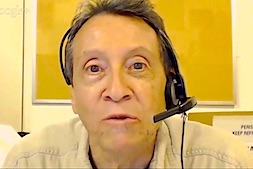
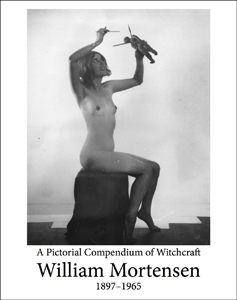
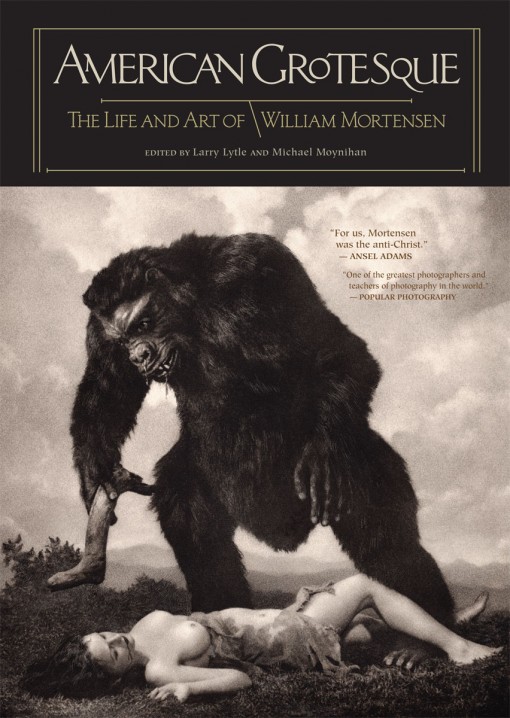
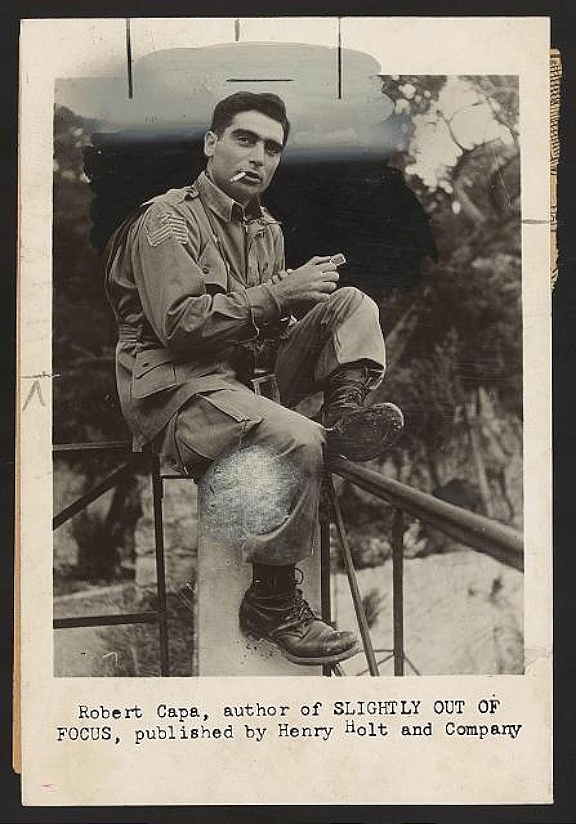


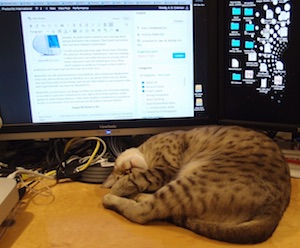
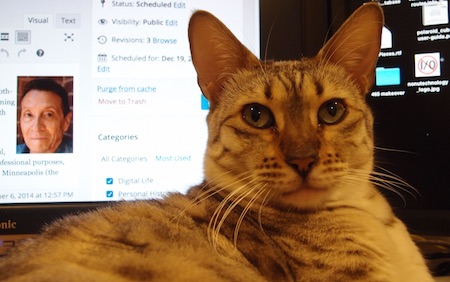




Many happy returns, Allan. Your writings have been an inspiration to my own, since reading The Grotesque in Photography and then your comments in The Journal of Post-Factory Photography, which led me to your Mortensen essay. I was also struck by another essay (1970s, collected in another book, can’t recall the title now) in which you spoke of the power that photographs hold over us — the example you gave was asking how many students in your classroom had photos of loved ones in their wallets, and then asking how many would be willing to destroy them. A notion that seems to have intriguing resonance today, when everyone (except me) carries their entire life, in images, on a smartphone.
Thanks for bringing so much insight into the world.
Liz Hand
Much appreciated. Your LA Times piece on the new Mortensen book is a model of the well-researched, considered review.
The passage you recall, about asking students if they’d burn their wallet photos, comes in my 1973 introduction to “First-Class Portraits,” an artist’s book published by the late, under-recognized Robert Delford Brown. (Worth your attention, I might add.) That’s in my 1979 collection of essays, Light Readings.
Happy Birthday Mr. Coleman,
I posted a small note on my Facebook page about Mortensen a few weeks ago. I had been asked to speak at a local camera club on three ways to improve your photograph. My first suggestion was to read one or more histories of photography. At the meeting I gave the example of how Mortensen had been left out of history by some historians. The next day a Smithsonian email publicized a huge new book on Mortensen. So I mentioned both on my Facebook page. I got an interesting response from someone defending Newhall. I didn’t have a dog in the fight either way. Every historian has to make choices on who is important and who is not in his or her point of view. But it still struck a nerve.
I know you don’t need one more yahoo telling you to keep up the good work, but please do. I have always enjoyed your writing. We need intelligent people thinking and writing about photography.
On a side note, we may be related, my mother’s family is Coleman, and they love to stir up an argument! But they are from KY. I am sure the closest most have been to NYC is NY style cheesecake.
Happy Birthday.
Tillman Crane
To the contrary, I always welcome both encouragement and support — even from “yahoos” (an unlikely self-description).
I have to disagree with your comment (re Newhall) that “Every historian has to make choices on who is important and who is not in his or her point of view.” Personal taste has no appropriate role in the discipline of historianship. You can’t eliminate internationally known, influential, widely published and exhibited figures from the history of a medium because you don’t like them, or their work, or their ideas. That’s just a version of the “vanishing commissar” in Soviet and Chinese Communist group photos — a fundamentally anti-historical attitude.
Nor, as a historian, can you simply eliminate or downplay a persistent, widespread tendency or way of working because, for some reason, you don’t think highly of it. Imagine a historian of 20th-century art who refused to discuss cubism — or collage, or surrealism, or abstraction, or appropriation, or (fill in any prominent, recognized artist’s name) — or paid them scant attention and treated them dismissively, because said historian didn’t think those approaches or that particular artist’s work constituted true art activity, which required the painter to render as accurately as possible whatever he or she saw.
Inconceivable, I’d say. Only in photography, with its woeful paucity of historians and consequent low standards for historianship, could someone evincing such a blatant bias get taken seriously as long as Newhall did.
Coleman is an Americanization of Cohen (on my father’s side of the family), so we’re not kin, though obviously we have things in common.
Thanks for your comments.
Hi Allan,
Just to wish you happy birthday with a little delay. You were born just a day after me.
Best,
Nissan
Happy Belated Birthday Allan!
I am impressed at your output, despite conditions, and how tech savvy it all is!! You’re not a typical geezer, my boy! Super Geezer more like. Wish I could say I’ve been as productive in 2014.
I will make a 2015 contribution to your website as soon as I get paid … ’bout time I became a sponsor! Give yourself a big hug for being your truly fabulous self, and a big hug to Anna too, for everything she does to make you happy and loved. XXXX, Cols